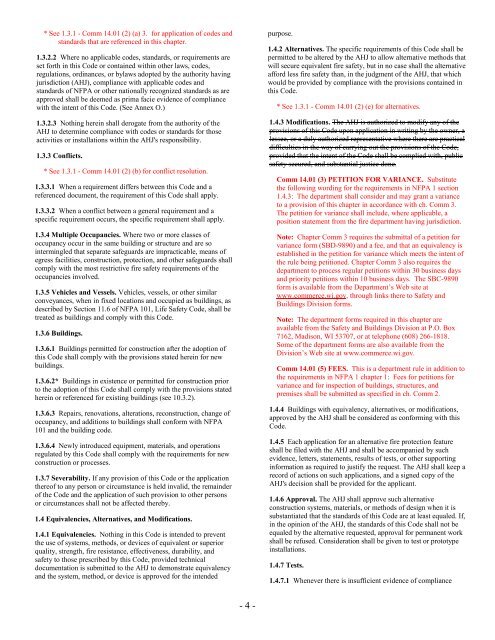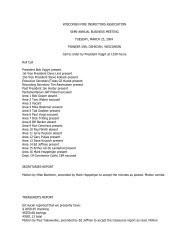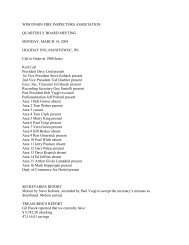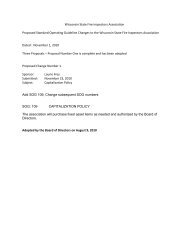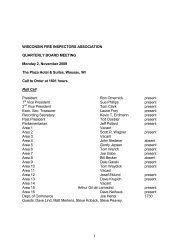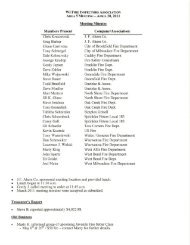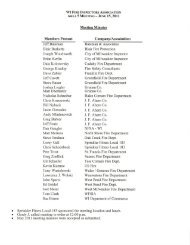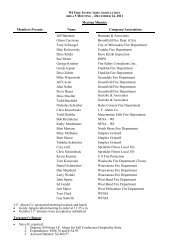Comm 14 Wisconsinism's & 2006 NFPA 1 Uniform Fire Code ...
Comm 14 Wisconsinism's & 2006 NFPA 1 Uniform Fire Code ...
Comm 14 Wisconsinism's & 2006 NFPA 1 Uniform Fire Code ...
Create successful ePaper yourself
Turn your PDF publications into a flip-book with our unique Google optimized e-Paper software.
* See 1.3.1 - <strong>Comm</strong> <strong>14</strong>.01 (2) (a) 3. for application of codes and<br />
standards that are referenced in this chapter.<br />
1.3.2.2 Where no applicable codes, standards, or requirements are<br />
set forth in this <strong>Code</strong> or contained within other laws, codes,<br />
regulations, ordinances, or bylaws adopted by the authority having<br />
jurisdiction (AHJ), compliance with applicable codes and<br />
standards of <strong>NFPA</strong> or other nationally recognized standards as are<br />
approved shall be deemed as prima facie evidence of compliance<br />
with the intent of this <strong>Code</strong>. (See Annex O.)<br />
1.3.2.3 Nothing herein shall derogate from the authority of the<br />
AHJ to determine compliance with codes or standards for those<br />
activities or installations within the AHJ's responsibility.<br />
1.3.3 Conflicts.<br />
* See 1.3.1 - <strong>Comm</strong> <strong>14</strong>.01 (2) (b) for conflict resolution.<br />
1.3.3.1 When a requirement differs between this <strong>Code</strong> and a<br />
referenced document, the requirement of this <strong>Code</strong> shall apply.<br />
1.3.3.2 When a conflict between a general requirement and a<br />
specific requirement occurs, the specific requirement shall apply.<br />
1.3.4 Multiple Occupancies. Where two or more classes of<br />
occupancy occur in the same building or structure and are so<br />
intermingled that separate safeguards are impracticable, means of<br />
egress facilities, construction, protection, and other safeguards shall<br />
comply with the most restrictive fire safety requirements of the<br />
occupancies involved.<br />
1.3.5 Vehicles and Vessels. Vehicles, vessels, or other similar<br />
conveyances, when in fixed locations and occupied as buildings, as<br />
described by Section 11.6 of <strong>NFPA</strong> 101, Life Safety <strong>Code</strong>, shall be<br />
treated as buildings and comply with this <strong>Code</strong>.<br />
1.3.6 Buildings.<br />
1.3.6.1 Buildings permitted for construction after the adoption of<br />
this <strong>Code</strong> shall comply with the provisions stated herein for new<br />
buildings.<br />
1.3.6.2* Buildings in existence or permitted for construction prior<br />
to the adoption of this <strong>Code</strong> shall comply with the provisions stated<br />
herein or referenced for existing buildings (see 10.3.2).<br />
1.3.6.3 Repairs, renovations, alterations, reconstruction, change of<br />
occupancy, and additions to buildings shall conform with <strong>NFPA</strong><br />
101 and the building code.<br />
1.3.6.4 Newly introduced equipment, materials, and operations<br />
regulated by this <strong>Code</strong> shall comply with the requirements for new<br />
construction or processes.<br />
1.3.7 Severability. If any provision of this <strong>Code</strong> or the application<br />
thereof to any person or circumstance is held invalid, the remainder<br />
of the <strong>Code</strong> and the application of such provision to other persons<br />
or circumstances shall not be affected thereby.<br />
1.4 Equivalencies, Alternatives, and Modifications.<br />
1.4.1 Equivalencies. Nothing in this <strong>Code</strong> is intended to prevent<br />
the use of systems, methods, or devices of equivalent or superior<br />
quality, strength, fire resistance, effectiveness, durability, and<br />
safety to those prescribed by this <strong>Code</strong>, provided technical<br />
documentation is submitted to the AHJ to demonstrate equivalency<br />
and the system, method, or device is approved for the intended<br />
purpose.<br />
1.4.2 Alternatives. The specific requirements of this <strong>Code</strong> shall be<br />
permitted to be altered by the AHJ to allow alternative methods that<br />
will secure equivalent fire safety, but in no case shall the alternative<br />
afford less fire safety than, in the judgment of the AHJ, that which<br />
would be provided by compliance with the provisions contained in<br />
this <strong>Code</strong>.<br />
* See 1.3.1 - <strong>Comm</strong> <strong>14</strong>.01 (2) (e) for alternatives.<br />
1.4.3 Modifications. The AHJ is authorized to modify any of the<br />
provisions of this <strong>Code</strong> upon application in writing by the owner, a<br />
lessee, or a duly authorized representative where there are practical<br />
difficulties in the way of carrying out the provisions of the <strong>Code</strong>,<br />
provided that the intent of the <strong>Code</strong> shall be complied with, public<br />
safety secured, and substantial justice done.<br />
<strong>Comm</strong> <strong>14</strong>.01 (3) PETITION FOR VARIANCE. Substitute<br />
the following wording for the requirements in <strong>NFPA</strong> 1 section<br />
1.4.3: The department shall consider and may grant a variance<br />
to a provision of this chapter in accordance with ch. <strong>Comm</strong> 3.<br />
The petition for variance shall include, where applicable, a<br />
position statement from the fire department having jurisdiction.<br />
Note: Chapter <strong>Comm</strong> 3 requires the submittal of a petition for<br />
variance form (SBD-9890) and a fee, and that an equivalency is<br />
established in the petition for variance which meets the intent of<br />
the rule being petitioned. Chapter <strong>Comm</strong> 3 also requires the<br />
department to process regular petitions within 30 business days<br />
and priority petitions within 10 business days. The SBC-9890<br />
form is available from the Department’s Web site at<br />
www.commerce.wi.gov, through links there to Safety and<br />
Buildings Division forms.<br />
Note: The department forms required in this chapter are<br />
available from the Safety and Buildings Division at P.O. Box<br />
7162, Madison, WI 53707, or at telephone (608) 266-1818.<br />
Some of the department forms are also available from the<br />
Division’s Web site at www.commerce.wi.gov.<br />
<strong>Comm</strong> <strong>14</strong>.01 (5) FEES. This is a department rule in addition to<br />
the requirements in <strong>NFPA</strong> 1 chapter 1: Fees for petitions for<br />
variance and for inspection of buildings, structures, and<br />
premises shall be submitted as specified in ch. <strong>Comm</strong> 2.<br />
1.4.4 Buildings with equivalency, alternatives, or modifications,<br />
approved by the AHJ shall be considered as conforming with this<br />
<strong>Code</strong>.<br />
1.4.5 Each application for an alternative fire protection feature<br />
shall be filed with the AHJ and shall be accompanied by such<br />
evidence, letters, statements, results of tests, or other supporting<br />
information as required to justify the request. The AHJ shall keep a<br />
record of actions on such applications, and a signed copy of the<br />
AHJ's decision shall be provided for the applicant.<br />
1.4.6 Approval. The AHJ shall approve such alternative<br />
construction systems, materials, or methods of design when it is<br />
substantiated that the standards of this <strong>Code</strong> are at least equaled. If,<br />
in the opinion of the AHJ, the standards of this <strong>Code</strong> shall not be<br />
equaled by the alternative requested, approval for permanent work<br />
shall be refused. Consideration shall be given to test or prototype<br />
installations.<br />
1.4.7 Tests.<br />
1.4.7.1 Whenever there is insufficient evidence of compliance<br />
- 4 -


